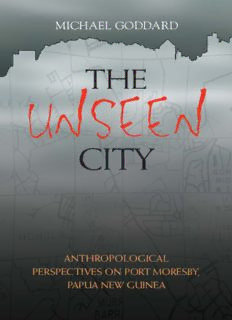
Unseen City: Anthropological Perspectives on Port Moresby, Papua New Guinea PDF
Preview Unseen City: Anthropological Perspectives on Port Moresby, Papua New Guinea
MICHAEL GODDARD THE UNSEEN CITY ANTHROPOLOGICAL PERSPECTIVES ON PORT MORESBY, PAPUA NEW GUINEA Pandanus Online Publications, found at the Pandanus Books web site, presents additional material relating to this book. www.pandanusbooks.com.au The Unseen City The Unseen City Anthropological perspectives on Port Moresby, Papua New Guinea MICHAEL GODDARD PANDANUS BOOKS Research School of Pacific and Asian Studies THEAUSTRALIAN NATIONALUNIVERSITY © Michael Goddard 2005 This book is copyright in all countries subscribing to the Berne convention. Apart from any fair dealing for the purpose of private study, research, criticism or review, as permitted under the Copyright Act, no part may be reproduced by any process without written permission. Typeset in Goudy and printed by Pirion, Canberra National Library of Australia Cataloguing-in-Publication entry Goddard, Michael. The unseen city : anthropological perspectives on Port Moresby, Papua New Guinea. Bibliography. ISBN 1 74076 134 0. 1. Urban anthropology — Papua New Guinea — Port Moresby. 2. Social structure — Papua New Guinea — Port Moresby. 3. Port Moresby (Papua New Guinea) — Social conditions. I. Title. 307.76099545 Editorial inquiries please contact Pandanus Books on 02 6125 4910 www.pandanusbooks.com.au Published by Pandanus Books, Research School of Pacific and Asian Studies, The Australian National University, Canberra ACT0200 Australia Pandanus Books are distributed by UNIREPS, University of New South Wales, Sydney NSW2052 Telephone 02 9664 0999 Fax 02 9664 5420 Production: Ian Templeman, Duncan Beard, Emily Brissenden To Debbie Acknowledgements The suggestion that I compile these essays into a book came from Sinclair Dinnen, who also helped find a publisher. I am grateful to audiences at a variety of institutions for their interest and comments at seminars and conferences at which material in this book was initially presented. I thank The Australian National University’s State, Society and Governance in Melanesia Project and the Law School of the University of the South Pacific for inviting me to the ‘Restorative Justice and Conflict Management in the Pacific Islands’ conference in Port Vila, Vanuatu, in June 2000, at which the final chapter was first presented. Subsequent to their original seminar presentations, the chapters herein were published as articles and I thank journal editors, particularly Michael Young, Neil Maclean and Geoffrey White, and anonymous reviewers for suggestions and advice. I have also benefited from discussions with Keith Barber, Nancy Bowers, Anou Borrey, Jean Kennedy, Jadran Mimica, Michael Monsell-Davis, Katayoun Rad- Hassall, Barry Morris, Maxine Pitts, the late Dawn Ryan, Bill Standish and Deborah Van Heekeren. The fieldwork on which the book is based was conducted mostly between 1990, when I was employed by the University of Papua New Guinea, and 1999, by which time I had moved to Australia. Fieldwork conducted after I moved from PNG at the end of 1994 was made possible by the National Research Institute of PNG, and I am particularly grateful to Michael Laki for his part in the provision of my research visa, and to Linus digim’Rina, head of the Department of Anthropology and Sociology at UPNG, for my affiliation to that institution. Denis Crowdy, Gima Rupa and Helen and David Lawrence provided hospitality and food for thought during visits in this period. My interest in the Village Court System, and particularly in its urban manifestations, began when I was asked by UPNG to take part in a consultancy in 1991. It was then that I met the Village Court Secretary, Peni Keris, who has since been invaluable through his authorisation of my continued access to his (very obliging) staff at all levels, as well as to documents and records, and to the courts themselves. I also thank the administrative staff at Bomana Jail for providing the means to conduct extensive interviews in the jail in 1991. Thanks also to the 50 inmates who took part in those interviews. My fieldwork would not have been possible without the patience, tolerance, assistance, friendship and companionship of a host of people who live in Port Moresby’s much-maligned ‘settlements’ — especially among the communities of Ranuguri, Ginigini (Vainakomu), Vanama, Paga, Erima and Four-Mile — and in the Motu-Koita village of Pari. In the various settlements, Imust thank in particular Andrew Kadeullo, Dai Andrew, Tagube Epi, Clement Mougla, Mege Baru, John Kameku, Michael Du, Martin Yaka, David Sul, Peter Piawa, Hamoka Palike, Simon Toni, Pita Kunz, Bernard Ambua, ‘Sanglas’ Matui, Josephine Maniti, the late Tati Marai, Andrew Moiri, Dirona Lohia, Molly Vani, David Kemi, Andrew Waip, Ben Aravape, James Mumurae and Jack Warebi. In Pari village, I owe special thanks to Lohia Daure, the late Gaba Gaudi, Puka Vagi, Morea Hekoi, Oala Igo, Sisia Baeau, Timo Puka, Eua Kohu, Sibona Gaudi, Lady Carol Kidu, Gaudi Kidu and Professor Sir Isi Kevau. The chapters in this book have been modified from previously published articles, with the permission of the original publishers: Chapter One from ‘From Rolling Thunder to Reggae: Imagining Squatter Settlements in Papua New Guinea’ in The Contemporary Pacific13 (1): pp.1–32, 2001.
